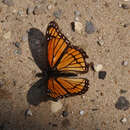Conservation Status
fornecido por University of Alberta Museums
Not of concern. Extirpated in BC (Guppy & Shepard 2001).
- licença
- cc-by-nc
- direitos autorais
- University of Alberta Museums
Cyclicity
fornecido por University of Alberta Museums
One brood per year, peak emergence in early to late July.
- licença
- cc-by-nc
- direitos autorais
- University of Alberta Museums
Distribution
fornecido por University of Alberta Museums
Great Slave Lake, NWT east to Nova Scotia, south to Florida and Mexico (Layberry et al. 1998, Scott 1986). Extirpated from southern BC (Guppy & Shepard 2001).
- licença
- cc-by-nc
- direitos autorais
- University of Alberta Museums
General Description
fornecido por University of Alberta Museums
The Viceroy is well-known for its mimetic resemblance to the Monarch (Danaus plexippus). The black median line across the hindwing is the quickest way to distinguish it from the Monarch. These two species can even be separated on the wing by their distinctive flight: Monarchs have a leisurely, floating flight and hold their wings at an angle above the body when gliding, while Viceroys hold their wings in a flat plane when gliding, a behaviour characteristic of the genus Limenitis.
- licença
- cc-by-nc
- direitos autorais
- University of Alberta Museums
Habitat
fornecido por University of Alberta Museums
Usually found in open, moist areas where willows grow.
- licença
- cc-by-nc
- direitos autorais
- University of Alberta Museums
Life Cycle
fornecido por University of Alberta Museums
"The eggs are initially pale yellow, turning greyish as they mature. Fully-grown larvae are olive-brown with a pink-white saddle, and resemble a bird dropping. The thorax bears two black, horn-like spines (Scott 1986). Third-instar larvae hibernate in a hibernaculum, a tube-like shelter made of a partially rolled-up leaf and silk.
It was initially believed that the Monarch-Viceroy resemblance was a case of Batesian mimicry, ie. the palatable Viceroy mimicking distasteful Monarchs. Recent research suggests that this is not the case, since Viceroys are also distasteful, so the two species are actually Mullerian mimics (Ritland and Brower 1991).
"
- licença
- cc-by-nc
- direitos autorais
- University of Alberta Museums
Trophic Strategy
fornecido por University of Alberta Museums
No Alberta data available, but larvae are known to feed on willows and poplars (Salix and Populus) elsewhere (Layberry et al. 1998).
- licença
- cc-by-nc
- direitos autorais
- University of Alberta Museums

